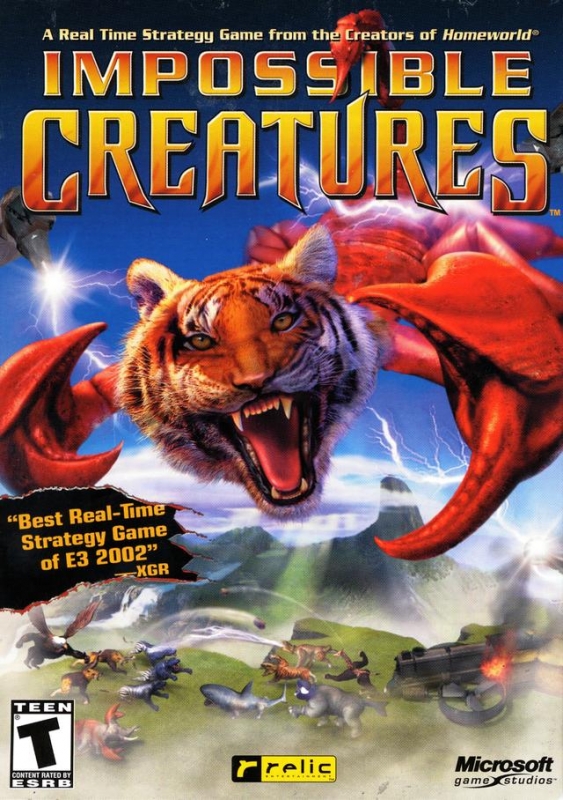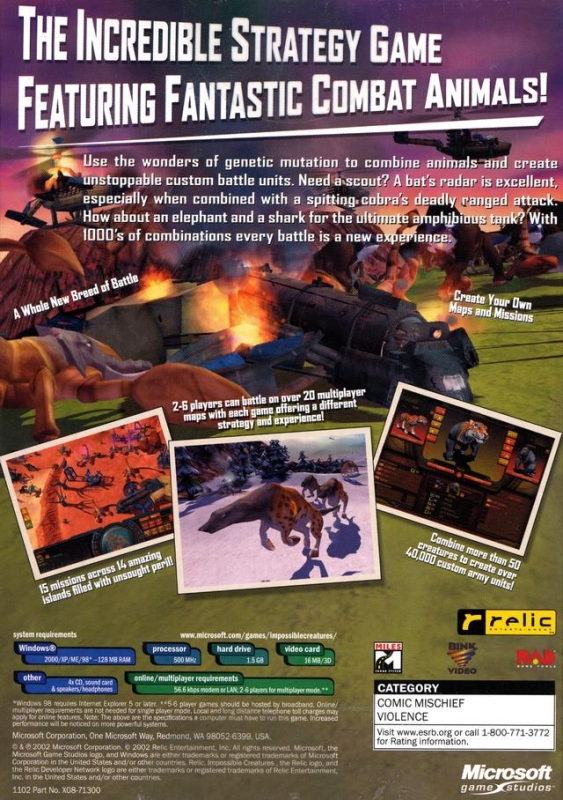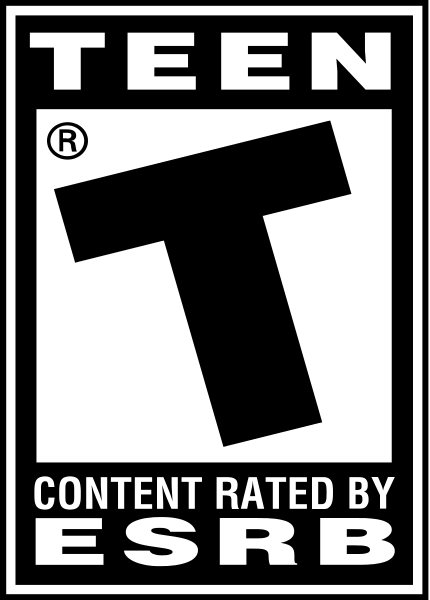Existing User Log In
New User Registration
Register for a free account to gain full access to the VGChartz Network and join our thriving community.





America - Front


America - Back



Relic
Strategy
 12/29/02 Microsoft Game Studios
12/29/02 Microsoft Game Studios  (Add Date)
(Add Date) 02/28/03 Microsoft Game Studios
02/28/03 Microsoft Game Studios
| Owners: | 4 | |
| Favorite: | 0 | |
| Tracked: | 0 | |
| Wishlist: | 0 | |
| Now Playing: | 0 | |
30th Apr 2018 | 1,944 views
The 2000s was a magical time to be a PC gamer, especially if you were fan of RTS games. After the absolute smash success of Age of Empires 2 and StarCraft proved the genre could be financially solid and PCs becoming more widespread and capable, there was a plethora of great RTS games that threw their hat at the ring to try and get some of that potential market. With this kind of gold rush, however, there were bound to be many hidden gems that were trumped and buried under the influx of titles, and were unable to make their mark in history. In a previous review I talked about Cossacks II, and how it tried to make a dent on the historical RTS category, just like Age of Empires, Rise of Nations or Empire Earth. However, history wasn’t the only inspiration for settings, science-fiction was also one of them. And in regards of classical science fiction, very few games are as unique and interesting as Impossible Creatures.
Impossible Creatures was released in 2003 for PCs by famous studio Relic Entertainment, who also worked on the Homeworld series, Company of Heroes and Dawn of War. The Impossible Creatures project begun after the original Homeworld, and it’s interesting how they were trying their unconventional spin on the RTS genre even back then. It’s also interesting to see this game was a co-joined venture with Microsoft, who published the game, no doubt confident in the RTS genre after their own titles were met with widespread success. However, it was quickly overshadowed by the two Homeworld games, and while the game is not a forgotten title by any means (the Steam version has a surprisingly amount of active players) it never really made a name for itself. Which is a shame, since the core game is extremely unique and has a lot of potential.
The basics of the game are simple. Like many RTS, Impossible Creatures has you gathering resources, building a base and armies to fight your enemies. However, the game revolves around the creation of the units. Unlike any other RTS I’ve encountered, you have the ability to create your own units from scratch, mixing and matching different animal species to create your preferred hybrid monstrosities, from a list of 76 species available (from the base game and the two free updates). The combining mechanic is the heart and soul of this game, and it affects every single aspect of the title. The idea is absolutely genius, and extremely ambitious by the time period. It adds a lot of depth to the battle system by having to plan and choose each creature and the parts it has to have from each animal (usually divided into head, front legs, back legs, torso, tail, pincers and wings). Each part has different stats and abilities, and the more powerful they are, the more expensive they will be to produce, while also having to keep an eye on the size as a stat multiplier and the required building and technology level needed for its production. Each player has nine slots in their arsenal, so they have to be really careful with what they choose. For example, picking only heavy animals will leave you defenseless during the early stages of the game (and zerg rushing in this game is quite a feasible strategy, especially with level II creatures, when they can use special bonus such as the Herding or Pack Hunter). At the same time, strategies that require lots of cannon fodder units will be weaker to plagues and poisons. If you only pick melee units you won’t be able to counter flying units, and if you choose too many flying creatures you will be vulnerable to the Anti-Air Towers, and artillery units can be tricky to use due to their attacks hurting their ally troops too. The Creature Combiner feature is pretty much like the family creator of the Sims, in what you can end up spending hours and hours just making different animals and armies instead of just playing the game. It also has a recommendation option, giving you an overview of your current army. It is a nice feature to create well-rounded builds, but if you have any particular strategy in mind you’re going to end up ignoring it. Once a creature is created, it will go to a catalogue, where you can see every single design made, useful if you ever imagine a nice mix, but it doesn’t fit with the rest of your army’s strategy. And while we’re talking about strategy, it is once again imperative to remark how important the design phase is. Unlike any other strategy game, where each faction has been crafted to be as balanced as it could possibly be, in this game there’s a real possibility of one army being much more powerful and useful than others in an objective way. Two equally skilled players with different armies will perform much differently, and while the game tries to keep everything balanced through ability availability, stats, costs and structural needs, there is the possibility of making extremely overpowered monsters. There’s also the problem with the base animals themselves, and how some of them are incredibly useful compared to others. The lobster, for example, is ridiculously overpowered: a level II creature that needs the Water Chamber has claws and the ability to regenerate wounds, has great defenses and HP while not being really that slow by itself, and resource-wise not being that expensive, it fits with almost any other animal and, if combined with a creature with horns, it becomes a melee monster, especially good obliterating buildings fast. Compare that to the skunk, whose only real good trait (outside of it being a cheap level I creature usable from the beginning) is its Stink Cloud ability, which slows enemies down, but without actually hurting them. A skilled player will find and identify the best creatures with time, and will find the best ways to use them. But then again, that always leaves the chance of the surprise use of a creature mostly overlooked, taking victory when no one thought possible.
I could talk about the Creature Mixer mechanic quite a lot, but it would be more repetitive, so I’ll move on to the actual game. Mechanical-wise, the game is similar to other RTS, with a base in need of defending, henchmen to build and gather resources and a map to explore. This, however, is where most of the game’s problems come from. There are only two resources in the game: coal and electricity. Electricity is automatically generated in special buildings and geothermal structures built over geysers, but coal is just found in mines. The mines are in the open, and are spread throughout the map. The game will depend on the players’ ability to either keep the most mines for themselves or to take their rivals down before running out of coal. And run out of coal you will, as the game is quite stingy with the coal available on the higher difficulties. You will have to pay attention to the emplacement of the coal on the map (which are not randomly generated, so the coal is always on the same spot, as well as player emplacement). During the game, you will only have one base available, the Lab, and you can’t create more. If the enemy destroys your lab, you lose the game. The games allow up to six players, and there are many gameplay modes, although in reality are only two. “Destroy Enemy Lab” and “Destroy Enemy Base”, which are basically the same, but in Destroy the Enemy Base you have to take down all enemy structures, which is just cumbersome, as the Lab’s destruction practically guarantees the defeat. In “Hunt Rex”, each player is given a human character, and they have to hunt down their enemies’. Again, destroy the lab and you will have all the time in the world to hunt the objective. And herein lies the problem: the game concentrates all of its depth on the creatures: how to use, how to combine them, how to upgrade them… but there is quite a lack of development of many other elements, and the scarce variety might get many players after a while.
Impossible Creatures, like many of its peers, has a campaign mode. Centered on the origins and creation of the Sigma technology, the tech responsible for combining creatures, and about its use and misuse. In 1937, Rex Chance, war journalist, receives a letter of his father, a remarked scientist, who’s been working on a series of islands on the South Pacific on some sort of secret project. Lo and behold, the technology has fallen in the hands of Upton Julius, a wealthy entrepreneur that is planning to take over the world. Rex is saved at the last moment by Lucy Willing, an associate of Rex’s father. Together, they have to fight Upton Julius and his generals to stop him from using it. Through 15 levels with different settings, you have to analyze different animals on each island, so that you’re able to use their DNA for your army. I love the setting, it reminds me of those classic monster movies, where the mad doctor creates something evil and tries to wreak havoc on everything it finds, and also a bit of Bioshock in aesthetics. The game has great cut scenes, drawn in black and white shots, although they have a dark, almost noire tone to them compared to the camp and fun attitude the game has most of the time. The campaign is a great distraction, but not really fleshed out, as with just 15 chapters, some of them quite short if you know what you’re doing, can go by rather fast. The style of this game is great. The main theme of the game is this fun jazz tune mixed with animal noises that really immerse you in the setting, and it has great 3D graphics for its time. They are close in quality to the Dawn of War models, which is unsurprising seeing that they both have the same dev team.
Multiplayer is… complicated. This game was made during the LAN era, and it shows. Despite it having a reasonably active community on Steam, the game is quite complex to get an online match running, so many just use LAN settings and simulation services for it. Also, there’s a dedicated modding community for this game, understandable due to the potential of the mechanics, and mods such as the Tellurian mod are almost of mandatory download they are so good and content-filled. The game also has a map creator, but it’s nothing special.
Impossible Creatures is one of those games that were ahead of their time in some areas while being weighted down in others. A game with more mechanical depth, better online and more gameplay options would be great, especially now that new animals can be added through updates and modding. Why the game doesn’t get a remake or a reboot is a mystery, but if I were to talk, I’d say the license is on shaky grounds after THQ’s bankruptcy. Right now, the game is published by THQ Nordic, and they have other projects to focus on, other than remaking a game that, for all intents and purposes was never a huge hit. Which is a shame, this game works great on modern systems, and it’s constantly on sale, so I highly recommend trying it out, even if it’s to just try the creature mixer mechanic. Seriously, it’s a blast.
Score: 8/10
| Total Sales |
0.00m
Japan |
0.00m
NA |
0.01m
Europe |
0.00m
Others |
0.01m
Total |
| 1 | n/a | n/a | 17 | 6 | 23 |
| 2 | n/a | n/a | 57 | 14 | 71 |
| 3 | n/a | n/a | 13 | 3 | 16 |
| 4 | n/a | n/a | 6 | 2 | 8 |
| 5 | n/a | n/a | 32 | 8 | 40 |
| 6 | n/a | n/a | 78 | 20 | 98 |
| 7 | n/a | n/a | 118 | 30 | 148 |
| 8 | n/a | n/a | 102 | 26 | 128 |
| 9 | n/a | n/a | 269 | 67 | 336 |
| 10 | n/a | n/a | 133 | 33 | 166 |
|
|
AussieGecko
posted 13/05/2009, 12:33
awesome game even got the expansion pack thing off the net Message | Report |